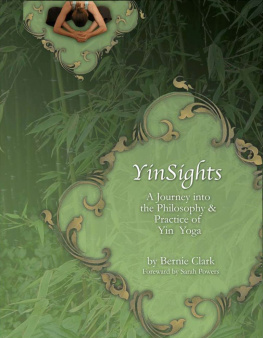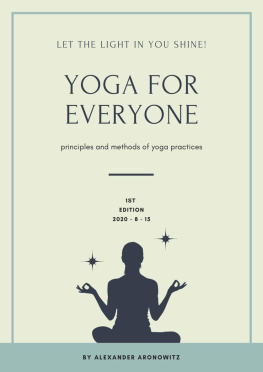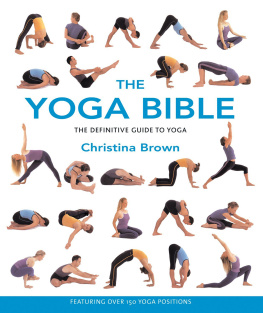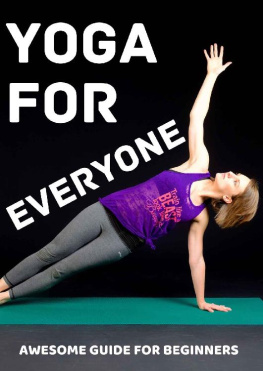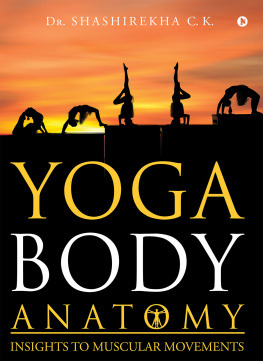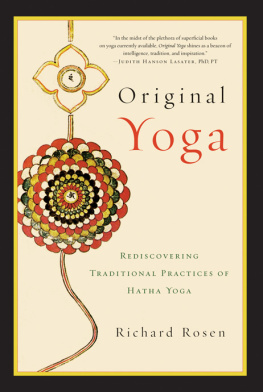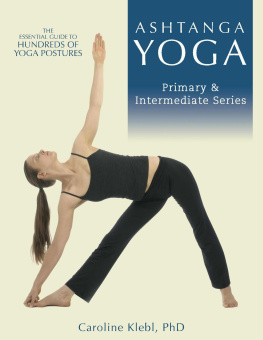yin | Yoga | Principles
& Practice |
yin | Yoga | Principles
& Practice |
10th ANNIVERSARY EDITION
paul grilley
White Cloud Press
Ashland, Oregon
Copyright 2012 by Paul Grilley. All rights reserved. No part of this book may be used or reproduced in any manner whatsoever without written permission except in the case of brief quotations embodied in critical articles and reviews.
Inquiries should be addressed to:
White Cloud Press
PO Box 3400, Ashland, Oregon 97520.
Website: www.whitecloudpress.com
Book Design: Confluence Book Services
Photography: Bruce Bayard
Illustrations: Ann DiSalvo
First edition: 2002
1213141516109 8 7 6 5 4 3 2 1
Library of Congress Cataloging-in-Publication Data
Grilley, Paul, 1958-
Yin yoga : principles and practice / Paul Grilley. -- 10th anniversary ed.
p. cm.
Includes bibliographical references.
ISBN 978-1-935952-75-6
1. Yin yoga. I. Title.
B132.Y6G678 2012
613.7'046--dc23
2012027786
Contents

This book is dedicated to my teachers,
Dr. Garry Parker, who taught me anatomy, Paulie Zink, who taught me Taoist Yoga, Dr. Hiroshi Motoyama, whose work demonstrates the unity of Taoist and Tantric practice.
Acknowledgements
I would like to thank my beautiful wife Suzee for posing and for the countless hours of discussion, Ann DiSalvo and Bruce Bayard for their artwork, Steve Sendar and Christy Collins of White Cloud Press for their support, and most especially Steve Scholl of White Cloud Press, who insisted this book be created in spite of my hesitations, I owe him a great debt.
It has been ten years of study, teaching, and practice since the first edition of this book, much of which is reflected in this second edition. I have expanded the psychological and theoretical descriptions of yin yoga and have tried to better prepare the student about what to expect when practicing. The meditation section has been completely rewritten and the practices elaborated in systematic detail. I have tried to show that controlling ones chi is the thread that leads from physical to emotional and spiritual development.
Whatever form of yoga the reader prefers, I hope she finds the outline of principles presented here useful to her future studies.
It was never my intention to promote yin yoga as an independent system of asana practice because yin yoga is, by definition, incomplete. It was and is my intention to promote yin yoga as a supplement to yang forms of exercise. Yang exercise is a broad term meant to include not just yang forms of yoga but any form of exercise that focuses on moving the blood and exercising the muscles; examples include weightlifting, running, cycling, and swimming.
Yin and yang forms of yoga balance each other. The meridians in our body can be favorably compared to irrigation canals: yin forms of yoga dredge the canal of accumulated debris, and yang forms of yoga stimulate the flow of fluid through them.
Yin and yang forms of yoga also balance us emotionally and mentally. Yin yoga soothes and calms us, yang yoga invigorates and refreshes us. Each form of exercise is needed at different times. The modern world is very yang; life should be a balance between competition and compassion, between ambition and contentment, but this balance has been lost. An overemphasis on yang qualities has polluted the planet, split our families, and emptied our homes while both parents work to get ahead or just to stay afloat. Yin yoga can help bring balance to an overly yang lifestyle.
It hasnt always been the case that yang is overemphasized. In some communities the opposite has been the case. In past times monks disease was a colloquial expression used to desribe someone who was overly sensitive to any disturbance. The antidote to monks disease is yang activity, which is reflected in the fact that hatha yoga, kung fu, chi gong, tai chi, and other yang forms of exercise originated in monastic communities. I have recently heard of a psychotherapist specializing in depression who wont accept clients unless they commit to a regular exercise program. Yin and yang are necessary aspects of a healthy life.
Any skill requires deliberate practice. This is as true of cultivating an inner calm as it is of becoming outwardly athletic. Yin yoga can help. Learning to stay in a pose for five minutes at a time trains the mind and body to become calm and endure distraction, both physical and mental. I took up the practice of yin yoga to cultivate greater flexibility in my joints, but what I discovered is a style of yoga that cultivates physical ease and mental calm. I have long abandoned my ambitions for greater range of motion, but the deeper qualities of yin yoga have kept me practicing for over twenty years.
Yoga in general is widely popular and socially acceptable. This is a seismic shift from the social norms of fifty years ago. I remember my grandmother telling me, If you have time to exercise then you have time to work, which was her way of saying my yoga practice was a waste of time. But my grandmother was a product of her generationshe raised a family during the Depression and lived through World War II, the Korean War, the Vietnam War, and the Cold War. Most of her adult life was spent doing the very real work of building up the physical infrastructure of the country she was born in.
My generation, that of the post-World War II baby boom, is heir to the labor and sacrifices of our parents and grandparents. Thanks to their work we live in a time of material luxury, and many of the physical dangers and diseases that threatened our grandparents seem distant to us. What then will be our contribution to the future? I believe part of the answer is to live noble lives, lives of kindness and tolerance and gratitude and contentment. But none of these things is possible if we are unable to control our impulses and quiet our minds.
I do not believe that happiness lies in carrying Darwinian survival of the fittest to its extreme. I do not believe that constant accumulation is the proper goal of a human being. I do believe, however, that it is noble and proper to voluntarily trace a circumference around our desires and to deliberately increase the time we spend cultivating kindness, tolerance, gratitude, and contentment. If my generation can pass down practical techniques that cultivate these qualities, then I think we have fulfilled part of our responsibilities to the next generation.
Three Threads of Recent History
What is yin yoga, and how did it get its name? This book is dedicated to three people who represent the three threads that are woven into yin yoga. The first is Dr. Garry Parker. Dr. Parker taught me anatomy and encouraged my first attempts at teaching yoga at Flathead Valley Community College in 1980. From him I learned to appreciate the scientific principles of human movement. It was because of him that I acquired the concepts and vocabulary to competently study anatomy on my own. My view of yoga was shaped by anatomy from the beginning, and I will always be grateful for this.
Next page

